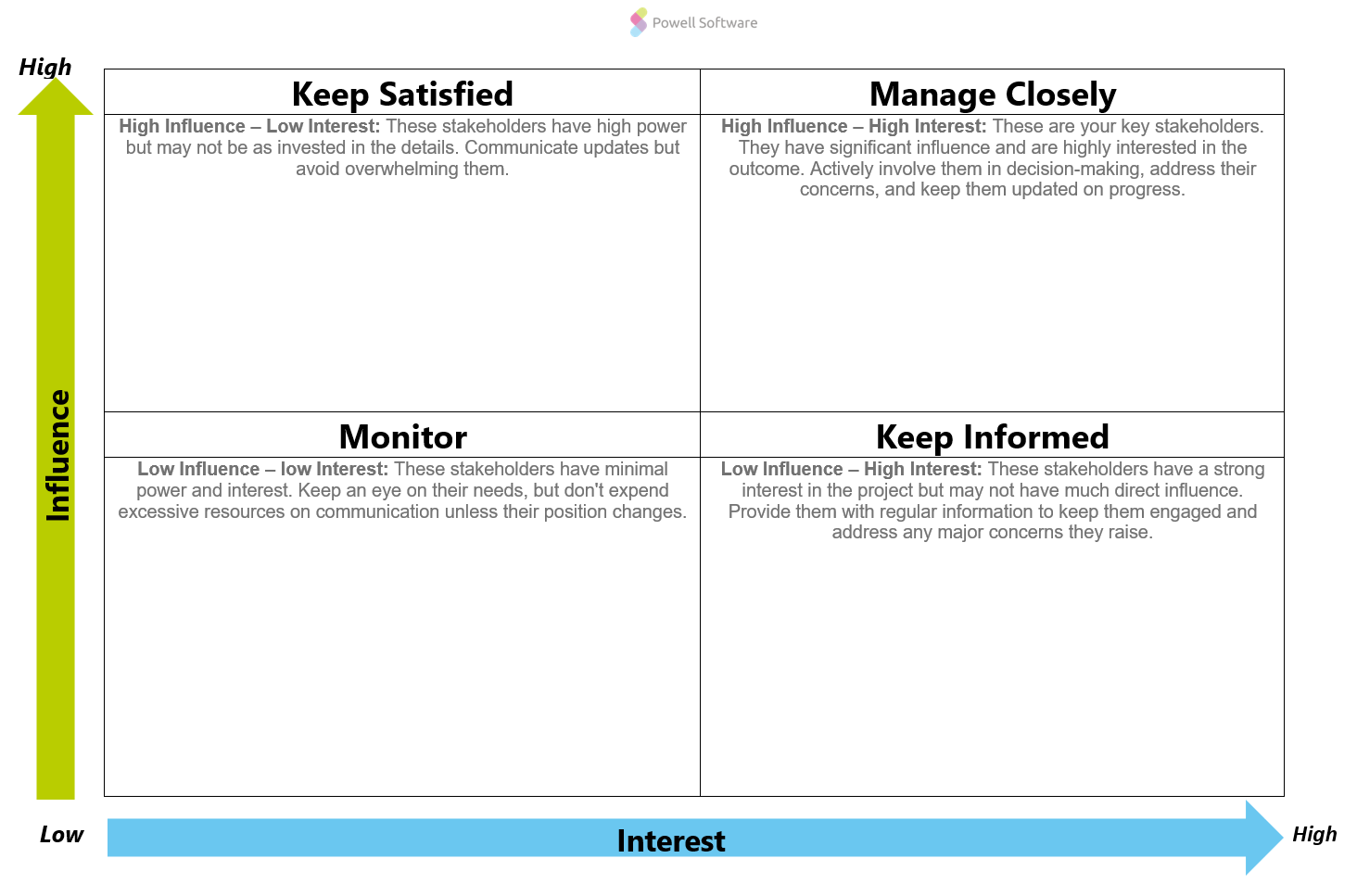The answer lies in a strategic approach to internal communication, and a key component is the intranet. A good intranet streamlines communication, supports remote work, and facilitates knowledge management. It also customizes content to meet specific departmental needs, aids in onboarding and training, reduces communication costs, and strengthens company culture. By investing in a custom intranet, managers can create a more connected, informed, and productive workplace. However, securing the resources and support to build or revamp your intranet requires navigating a complex landscape of stakeholders. This is where stakeholder mapping comes in.
What is stakeholder mapping?
Stakeholder mapping is a strategic process that involves identifying, analyzing, and prioritizing the various individuals or groups who have a stake in a project. By mapping out stakeholders, you can gain insights into what different groups need from the intranet, allowing you to tailor communication strategies for maximum impact. This could include specific functionalities, access to certain types of information, or even preferences for how information is presented. Knowing who your stakeholders are and what they need ultimately ensures that your intranet aligns with the overall business goals and addresses the needs of the employees.
Identifying stakeholders early also allows you to anticipate potential challenges and address them proactively. This can include managing resistance to change or resolving conflicts between different departments. This allows you to focus your efforts on engaging the most influential stakeholders and ensuring they are on board with the project. Once you understand the needs and concerns of various stakeholders, you can use this information to build consensus. Engaging stakeholders early in the process ensures they feel heard and valued, which can increase their support and participation in the project.
How do you identify stakeholders in your project?
Within the collaborative framework of an intranet project, key players emerge with distinct roles.
- Executives and Senior Management: Crucial for approving budgets and setting the strategic direction, ensuring the intranet project aligns with the company’s overarching goals. Present a detailed analysis showcasing how a modern intranet can reduce communication costs and streamline operations. Demonstrate potential ROI by highlighting similar successful projects in the industry.
- IT department: Responsible for managing the technical infrastructure, ensuring the security and compliance of the system, and integrating the new intranet with existing systems. Their main concerns are system stability, data security, and ease of maintenance and scalability.
- Legal Department: Safeguards compliance and mitigates potential risks. Involve the legal team early to identify and address compliance risks, preventing costly delays.
- Department heads: They play a key role in encouraging employee adoption of the intranet. They look for features that support their department’s specific requirements and facilitate knowledge sharing within their teams. Conduct departmental workshops to gather requirements. For example, ensure integration with CRM for Sales or onboarding features for HR, as needed.
- Employees: As end-users, they value a user-friendly interface and easy access to relevant information. Gather feedback through focus groups to address their pain points and preferences. This can result in an intuitive interface and mobile accessibility, ensuring high adoption rates.
Stakeholder Mapping Matrix
A helpful tool for navigating these diverse stakeholders is a Stakeholder Mapping Matrix. This framework categorizes stakeholders based on their level of influence over the project and their level of interest in its success.
An example of individual stakeholder mapping can be downloaded here.
Here’s how to categorize stakeholders using the matrix:
Step 1: Identify your stakeholders:
Start by brainstorming all the individuals or groups who might be affected by your project. This could also include:
- Project Sponsors: The individual or department championing the project will have significant influence and a strong interest in seeing it succeed.
- Finance Department: They may control project budget and have the power to approve expenditures, although their direct project involvement may be limited.
- Human Resources: Involved in using the intranet for employee onboarding, training, and engagement. HR provides valuable input on features that can support employee development and satisfaction.
- Marketing Department: May utilize the intranet for internal campaigns, sharing marketing resources, and collaborating on marketing strategies. Their input can help in designing features that support marketing activities.
Step 2: Assess stakeholder influence:
For each stakeholder, consider their level of influence over the project’s success.
- Can they block progress or make key decisions?
- Do they control essential resources?
- Can they influence perception or internal buy-in?
Step 3: Assess Stakeholder Interest:
Evaluate each stakeholder’s level of interest in the project’s outcome.
- How directly are they impacted by the project’s success or failure?
- Do they have a personal or professional stake in the results?
- Are they actively seeking information or updates?
Step 4: Categorize Stakeholders in the Matrix:
Now, use the matrix with “Influence” (High vs Low) on the Y-axis and “Interest” (High vs Low) on the X-axis. Based on your assessments, place each stakeholder in the appropriate quadrant.
Strategies for effective stakeholder engagement
To get the best results from stakeholder engagement, start by understanding their specific requirements and then customize your interaction style to fit them.
For Key Decision-Makers (high influence, high interest), prioritize direct communication. Schedule one-on-one meetings and personalized briefings to delve into the project’s strategic impact, alignment with organizational goals, and potential return on investment (ROI).
Potential Disruptors (high influence, low interest) may not require the same level of detail. Keep them informed with periodic email updates, concise reports highlighting key milestones achieved, and invitations to major project events. Emphasize the project’s compliance with regulations, risk mitigation strategies, and the positive consequences of its success.
Project Champions (low influence, high interest) are enthusiastic supporters. Foster their engagement through regular team meetings, collaborative workshops, and internal communication platforms. Share progress updates, solicit their feedback, and highlight how the project can improve their daily work.
For Observers (low influence, low interest), utilize broader communication channels like company newsletters and internal website announcements. Focus messaging on the project’s overall benefits to the organization and how it contributes to a positive work environment.
Overcoming challenges in stakeholder engagement
Stakeholder engagement is vital for project success, but navigating diverse groups with varying needs presents challenges.
- One major hurdle is information overload. Stakeholders may be bombarded with communication from numerous projects, making it difficult for yours to stand out.
- Competing priorities further complicate matters, as stakeholders have limited time and attention to dedicate to each initiative.
- Additionally, communication styles and preferred formats differ. Some may favor detailed reports, while others appreciate concise updates.
- Perhaps the most significant challenge lies in potential conflicts of interest. Stakeholders may have varying priorities and goals for the project, leading to friction.
Fortunately, strategies exist to overcome these obstacles:
- Start by building relationships with key stakeholders early on. This will foster trust and increase their willingness to engage and contribute.
- Define communication protocols at the outset. This includes the frequency of updates, preferred communication channels, and how stakeholders can provide feedback.
- Embrace Transparency and Collaboration by addressing potential conflicts head-on. Facilitate open discussions where stakeholders can voice their concerns.
- Highlight the benefits that a well-developed intranet solution can offer. These include fostering seamless communication and collaboration across departments, centralizing and streamlining access to critical information, and ultimately boosting employee productivity. Additionally, a user-friendly intranet can enhance company culture by fostering a sense of community and promoting knowledge sharing.
How Do You Prioritize Stakeholders in Stakeholder Mapping?
In stakeholder mapping, prioritizing stakeholders is a crucial step that ensures resources and communication efforts are targeted where they matter most. The process typically involves assessing two main factors: stakeholder influence and stakeholder interest. Stakeholders with high influence and interest are the most critical and should be prioritized for regular communication and active engagement. These stakeholders are typically decision-makers or key contributors to the project’s success.
A common method to prioritize effectively is to use a matrix that categorizes stakeholders based on their influence and interest. For example:
- High-influence, high-interest stakeholders (such as executives) require ongoing, detailed engagement.
- High-influence, low-interest stakeholders (like regulatory bodies) may only need monitoring but with periodic updates.
- Low-influence, high-interest stakeholders (e.g., team members) should be kept informed but do not require as much involvement.
- Low-influence, low-interest stakeholders can be minimally engaged.
By assigning stakeholders to these categories, organizations can determine the right level of communication, ensuring that the most critical stakeholders receive the attention they need to support the project or organizational goals.
How Does Stakeholder Mapping Improve Communication and Engagement?
Stakeholder mapping is essential for improving communication and engagement across projects or business initiatives. By identifying each stakeholder’s role, level of influence, and interest, teams can tailor their communication strategies to meet the specific needs of each group. This targeted approach ensures that stakeholders are engaged at the right time, with the right message, using the most appropriate channels.
For example, corporate communication strategies often benefit from stakeholder mapping because it allows for creating integrated communication plans that address the concerns of each stakeholder group. Those with more influence or heavily invested in the project will likely need more in-depth updates and involvement in collaborative decision-making. In contrast, others may only require occasional briefings.
This structured approach to communication fosters stronger employee collaboration and improves overall engagement by making stakeholders feel heard and valued. Better engagement often leads to smoother project execution, higher satisfaction levels, and stronger alignment with business goals.
Conclusion
Stakeholder mapping is more than just identifying names and roles. It’s a strategic process that empowers you to understand your project’s ecosystem, anticipate challenges, and build a strong foundation for success. By effectively navigating stakeholder needs and concerns, you ensure project alignment and ultimately achieve buy-in from all parties involved.
Remember, stakeholder mapping is an ongoing process. As your project progresses, revisit your map and adapt your communication strategies accordingly. By keeping stakeholders informed, engaged, and valued, you can leverage their diverse perspectives to achieve a truly successful outcome.
For those eager to translate your vision into reality, our resource center offers a wealth of additional information. Download it here for detailed tips, templates, and examples that will help you craft that winning proposal.
To further explore how a customized intranet can drive your internal communication strategy, discover more about Powell Intranet. For insights into intranet effectiveness and planning, check out our Intranet Survey and learn about key Intranet Requirements to ensure your project’s success.






